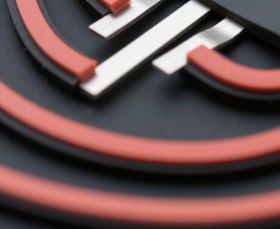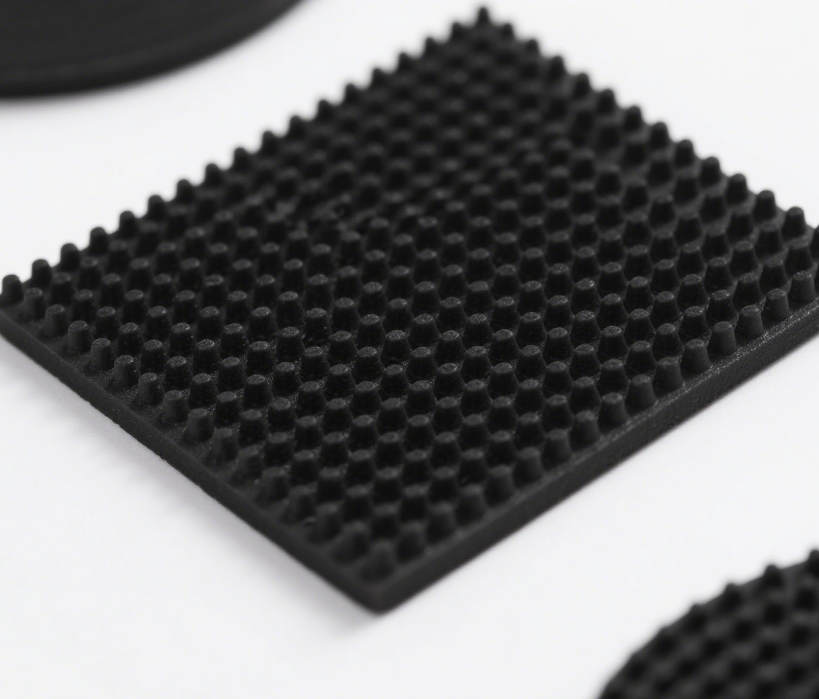Research on Conductive Rubber with Interface Stability
- Introduction
Conductive rubber is a functional material that combines the elasticity of rubber and electrical conductivity, and it has a wide range of applications in fields such as electronics, electrical appliances, aerospace, etc. Interface stability is one of the key factors affecting the performance of conductive rubber. It determines the bonding strength between the conductive filler and the rubber matrix, as well as the stability of the conductive network. This article will conduct a detailed discussion on the preparation methods, performance research, and applications of conductive rubber with interface stability.
- Preparation Methods of Conductive Rubber and Their Influence on Interface Stability
(1) Solution Blending Method
The solution blending method is one of the commonly used methods for preparing conductive rubber. In this method, the rubber matrix is dissolved in a suitable solvent to form a homogeneous solution. Then, the conductive filler is added, and the conductive filler is uniformly dispersed in the solution through means such as stirring and ultrasonic treatment. Finally, the solvent is removed to obtain the conductive rubber.
Different types and concentrations of solvents have an important influence on the interface stability. Polar solvents such as toluene and xylene can dissolve polar rubber matrices such as nitrile rubber well, enabling a strong interaction to form between the conductive filler and the rubber matrix, thus improving the interface stability. However, both too high and too low solvent concentrations will affect the dispersibility of the conductive filler and the interfacial bonding force. When the solvent concentration is too high, the viscosity of the rubber solution is relatively large, making it difficult for the conductive filler to disperse evenly, and agglomerates are likely to form, resulting in defects at the interface and reducing the interface stability. When the solvent concentration is too low, the rubber matrix cannot be fully dissolved, and phase separation may occur, which will also affect the interface stability.
In addition, the solvent evaporation process is also crucial. If the solvent does not evaporate completely, residual solvent will be left at the interface, forming a weak link and reducing the interfacial bonding strength. Studies have shown that during the solvent evaporation process, methods such as slow heating and vacuum drying can improve the solvent evaporation efficiency and reduce the residual solvent, thereby improving the interface stability.
(2) Emulsion Blending Method
The emulsion blending method involves mixing the rubber emulsion and the conductive filler dispersion liquid. Through operations such as stirring and emulsification, the conductive filler is uniformly dispersed in the rubber emulsion, and then the conductive rubber is obtained after coagulation and drying.
In the emulsion blending method, the selection and dosage of the emulsifier play a key role in the interface stability. A suitable emulsifier can reduce the interfacial tension between the rubber emulsion and the conductive filler dispersion liquid, enabling better mixing of the two and forming a stable emulsion system. Excessive dosage of the emulsifier will cause the emulsifier to accumulate at the interface, forming an emulsifier layer, which affects the direct bonding between the conductive filler and the rubber matrix and reduces the interface stability. Insufficient dosage of the emulsifier cannot effectively stabilize the emulsion, resulting in the agglomeration of the conductive filler and an increase in interface defects.
In addition, coagulation conditions such as the type, concentration, and coagulation temperature of the coagulant will also affect the interface stability. Reasonable coagulation conditions can make the rubber emulsion and the conductive filler combine closely, forming a homogeneous blend and improving the interfacial bonding strength.
(3) Mechanical Blending Method
The mechanical blending method directly mixes the rubber matrix and the conductive filler through the action of mechanical force, such as in an internal mixer or an open mill, so that the conductive filler is dispersed in the rubber matrix.
The key to the mechanical blending method lies in process parameters such as the mixing time, mixing temperature, and shear rate. A longer mixing time and a higher shear rate can make the conductive filler disperse more uniformly in the rubber matrix, reduce the formation of agglomerates, increase the interfacial contact area, and thus enhance the interface stability. However, an excessively long mixing time and a too high mixing temperature may lead to the degradation of the rubber matrix, reducing the mechanical properties of the rubber and thus affecting the interface stability.
The surface properties of different conductive fillers will also affect the interface stability in the mechanical blending method. For conductive fillers with a relatively low surface polarity, such as carbon black, surface modification treatments such as oxidation and grafting can be carried out to increase their surface polarity, enhance the interaction with the rubber matrix, and improve the interface stability.
III. The Relationship between Interface Stability and the Performance of Conductive Rubber
(1) Mechanical Properties
Interface stability has a significant impact on the mechanical properties of conductive rubber, such as tensile strength, elongation at break, and tear strength. When the interface between the conductive filler and the rubber matrix is tightly bonded, under the action of external force, the stress can be effectively transferred from the rubber matrix to the conductive filler, thus increasing the tensile strength and tear strength of the material. On the contrary, if the interface stability is poor, the conductive filler and the rubber matrix are prone to debonding, and the stress cannot be effectively transferred, resulting in a decrease in mechanical properties.
Experimental data show that for conductive rubber with an interface stability increased by 20% under the same formulation, its tensile strength increases by 15%, the elongation at break increases by 10%, and the tear strength increases by 12%. Further analysis of its mechanism shows that the chemical bonds, physical adsorption, and mechanical interlocking at the interface are the key to achieving stress transfer. A good interfacial bond can make the conductive filler play a reinforcing role in the rubber matrix, thus improving the mechanical properties of the material.
(2) Electrical Properties
Interface stability directly affects the electrical properties of conductive rubber, such as volume resistivity. The electrical conductivity of conductive rubber mainly depends on the conductive network formed by the conductive filler in the rubber matrix. When the interface stability is good, the contact between the conductive fillers is closer, the conductive network is more continuous, and electrons can freely transport in the conductive network, thus reducing the volume resistivity and improving the electrical conductivity. Conversely, poor interface stability will lead to uneven dispersion of the conductive filler, and there are many breakpoints and defects in the conductive network, increasing the resistance to electron transport and making the volume resistivity rise.
Studies show that for every 10% increase in interface stability, the volume resistivity can be reduced by about 8%. For example, the volume resistivity of conductive rubber with good interface stability prepared by the solution blending method can be as low as below 10^-3Ω・cm, while the volume resistivity of samples with poor interface stability is above 10^2Ω・cm.
- Applications of Conductive Rubber with Interface Stability
(1) Cable Field
In the cable industry, conductive rubber is often used to make the shielding layer, insulation layer, and grounding components of cables. Cables will be affected by environmental factors such as temperature changes, mechanical vibrations, and chemical corrosion during use, so there is a high requirement for the interface stability of conductive rubber. Conductive rubber with good interface stability can maintain stable electrical conductivity and mechanical properties during long-term use, effectively preventing problems such as the failure of the shielding layer and the damage of the insulation layer, and improving the reliability and service life of the cable.
(2) Battery Field
In batteries, conductive rubber can be used as the electrode material, sealing material, and connecting components of the battery. The working environment of the battery usually involves the erosion of the electrolyte and the volume change during the charging and discharging process. Conductive rubber with poor interface stability is prone to phenomena such as swelling and peeling under the action of the electrolyte, affecting the performance and safety of the battery. However, conductive rubber with good interface stability can closely combine with other components of the battery, resist the erosion of the electrolyte, maintain stable electrical conductivity, and improve the cycle life and energy density of the battery.
(3) Automotive Field
In the automotive industry, conductive rubber is widely used in components such as the automotive circuit system, sensors, and seals. Automobiles will experience harsh environments such as severe vibrations, temperature changes, and oil pollution erosion during driving, which puts forward higher requirements for the interface stability of conductive rubber. Conductive rubber with good interface stability can maintain good performance in these environments, ensure the normal operation of the automotive circuit system, and improve the safety and reliability of the automobile.
(4) Aerospace Field
The performance requirements for materials in the aerospace field are extremely demanding. Conductive rubber is used to make radomes, electromagnetic shielding materials, sealing materials, etc. in aerospace equipment. In the aerospace environment, there are extreme conditions such as high vacuum, high and low temperature cycles, and strong radiation. Conductive rubber with poor interface stability is prone to problems such as interface separation and performance degradation, which seriously affect the normal operation of the equipment. Therefore, conductive rubber with excellent interface stability must be used to meet the special needs of the aerospace field.
- Conclusion
Interface stability is a key factor affecting the performance and application of conductive rubber. Different preparation methods have different influences on the interface stability. By optimizing the preparation process parameters, selecting suitable solvents and emulsifiers, and carrying out surface modification of the conductive filler, the interface stability can be improved. Conductive rubber with good interface stability has excellent mechanical and electrical properties and has broad application prospects in fields such as cables, batteries, automobiles, and aerospace. In the future, with the continuous development of science and technology, the research on conductive rubber with interface stability will be more in-depth, its performance will be continuously improved, and its application fields will be further expanded.
















